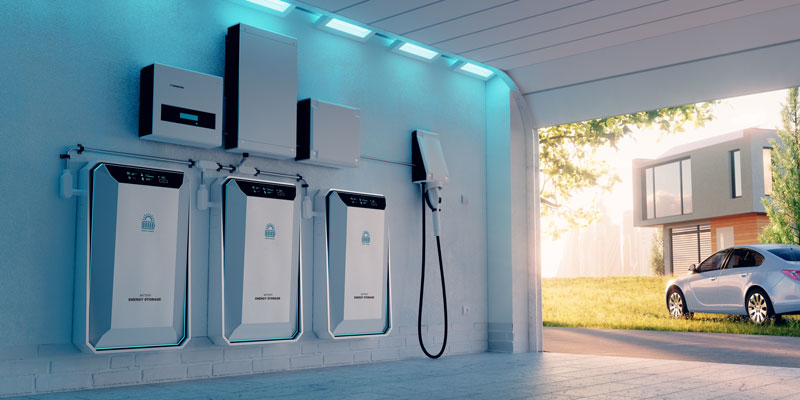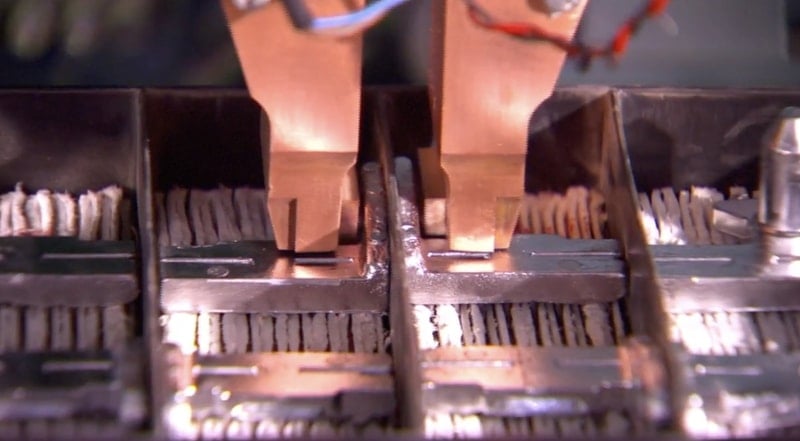Whether your home batteries are in a wall-mounted unit or a straightforward and safe battery box, they serve the same purposes.
But you’ll see a lot of hype and promises about what’s inside the box, including:
- “10-year lifespans” (don’t read the fine print!)
- Near-endless power (if you turn off your HVAC, fridge, and everything but a lightbulb)
- “Greener” energy storage (from batteries that will be landfilled)
- Zero-maintenance (but every home battery requires some inspection or maintenance)
Compare those claims with the home battery “secret” that makes shady salespeople squirm: No battery is perfect.
No battery is right for every house, operating environment, or maintenance habits – including our products.
Shinier isn’t necessarily better.
And you’ll want to double-check marketing claims – using the tips you’ll learn here.
Once you understand what to look for and how to get started, selecting the best battery for your home, lifestyle, and budget is easy.
And a bit of homework up front ensures you won’t get taken advantage of – or end up with a lemon.
After all, your family’s safety, money, and home are on the line.
In this blog post, you’ll discover how to get started with home batteries, including:
- What’s your goal?: 3 ways to benefit from home batteries
- Pros and cons of popular home battery options
- Don’t start with batteries (do this instead)
- How to find a trustworthy home battery installer – and spot red flags
- Simple rules that ensure your batteries get sized and installed right – so they last longer and work better
How home batteries benefit you
Because home batteries come in various shapes and sizes (storage capacities), you have options – whether you want to run your fridge and laptop for a few hours, power your house for a week, or ditch electric bills forever.
Backup power: Home batteries can protect you from power outages that shut down fridges, heaters, air-conditioning, and home offices – to ensure you’re safe and comfortable in any weather. Batteries often have lower lifetime costs than fossil-fuel generators, with less maintenance. And batteries are silent, much lower-carbon, and don’t emit toxic fumes.
Renewable energy storage and selling electricity: Batteries can store energy from the grid, solar panels, or wind turbines. You can use stored energy when needed or when electricity is more expensive (if your electric company charges Time of Use rates). And depending on where you live, you can sell energy to your power company.
Living off-grid: If you’re tired of electric bills or prefer to live somewhere remote, batteries are a requirement to keep the lights on. For an inside look, read North American Clean Energy’s case study, "Living the Dream of Net-Zero Energy & Storage".
Let’s compare the most common battery types:
Recyclable, flooded lead-acid (FLA) batteries are trusted in more installations than any other batteries – and that’s because they offer:
- High reliability – which is why they’re trusted in hospitals, off-grid schools, and millions of homes.
- Proven safety in homes, with no multi-day thermal runaway
- Low up-front cost (30%-90% less $ than competitive technologies)
- 99% recyclability (Source: US Environmental Protection Agency’s (EPA) “Advancing Sustainable Materials Management”)
- Medium power density
- Long life – up to 10+ years with proper selection and sizing, storage, use, and maintenance
One potential deal-breaker for FLA batteries: They require regular maintenance and watering. While this is often just a few minutes a month, some prefer hands-off batteries, especially for vacation homes.
Absorbent glass mat (AGM) batteries are built using similar technology, but they’re sealed; AGM batteries provide extended service life, faster charging, and high current delivery (important for homes) – with near-zero maintenance.
FLA and AGM batteries have powered homes for more than 100 years. But while the battery cases look similar, next-gen FLA and AGM batteries are engineered with 3D printing and computer modeling – and robotically assembled.
Lithium-ion (LI) batteries are less common, but they’re also near-zero maintenance. And they offer the highest power density (more energy in a smaller space).
Disadvantages of LI batteries are the risk of thermal runaway (and home fires), higher cost (often 3X more than comparable FLA models), and lack of recycling.
According to Chemical and Engineering News, “... because researchers have made only modest progress improving recyclability, relatively few Li-ion batteries end up being recycled.”
If the environment and climate change are part of your home battery decision, check out North American Clean Energy’s "How to Spot Greenwashing in Energy Storage".
The right home battery works for your home, operating temperatures, habits, risk tolerance, and finances.
Because home batteries integrate with your electrical system, they’ll also require additional equipment.
What other equipment do you need?
Installation will be simple and straightforward if you get an electric bill every month and want battery backup or peak shaving. In addition to batteries, you’ll probably require a subpanel and may need an inverter.
You'll need more energy if you want to store renewable energy or live off-grid. That means larger batteries, along with an inverter and additional electrical equipment. Your system can reduce your monthly expenses and carbon footprint, and you can decide how long you want to be able to power everything with your batteries.
TIP FOR HOMEOWNERS: Check with your installer to see how the up-front cost can be rolled into a mortgage, depreciated, and/or qualify you for tax credits.
Reduce your energy needs before you size your batteries.
The less energy your home uses, the less money you’ll spend on batteries (and solar+wind). That’s because you’ll need fewer, lower-capacity batteries.
Now, we’re betting you’ve already swapped out old lightbulbs for LEDs.
The real savings comes from reducing your heating and cooling loads... and replacing energy-hogging appliances with Energy Star models. Consider an independent energy audit to determine what will benefit you the most. Typically, you’ll get the most comfort and savings from better air-sealing (so you don’t lose warm/cool air). Next up are improving insulation and upgrading to heat pumps.
To learn more about energy-saving tips for your home, read "7 Costly Battery Mistakes."
RED FLAG: If a battery salesperson immediately recommends an energy storage system without determining how much power you need – and where you could save energy – run away.
Find the right system designer/installer
The right home battery sizing, design, and installation can ensure reliable power for years to come.
It’s tempting to choose a company that promises everything in one box. And some of them are great (others aren’t).
But you may benefit from an expert who optimizes components precisely for your home and electrical usage.
When comparing installers or battery salespeople, always ask for testimonials and recommendations. And get installers’ insurance and accreditations in writing.
Finally, compare written estimates. Be sure all companies are promising – in writing – the same amount of usable battery capacity (sized for 50% DOD). And look for thorough estimates that break down steps for installation and list components by name; this level of precision often indicates how much attention to detail the installer will put into your project.
Your installer should ask you questions like:
- What’s your goal for your home batteries? (A few hours’ backup power is totally different from an off-grid system.)
- How much power do you need?
- For how long?
- What will you power?
- What’s your budget?
Make sure your batteries are sized, installed, and stored properly
Some of the most common ways home batteries die are:
- Exposure to extreme temperatures
- Electrical code violations
- Undersized batteries
That’s why good home battery installers typically house batteries in insulated boxes in locations with mild temperatures. And they follow all relevant electrical codes. For an overview of best practices for installation and monitoring, check out renewable energy installer Mark Snyder’s “How to Avoid On-Site Visits and Unpaid Battery Work".
For battery sizing, your battery expert or installer should be able to calculate how much energy storage you’ll need.
And these quick rules will help you check their work:
Rule #1: Always size for 50% Depth of Discharge (DOD) for any home battery
DOD tells you how much of a battery’s stored energy can be used. (For instance, 40% DOD means 60% of a battery’s energy is still available.)
Some companies claim their batteries can be discharged 100% -- but that leaves you with 0% of your batteries’ electricity. So you’re out of power. And deep discharging kills any batteries early. It might also nullify your warranty.
So why would somebody sell a home battery that’s too small? Hint: Some batteries cost a lot more per Ampere-hour, and that’s a hard sell – if they compare apples to apples.
Rule #2: Plan for probable worst-case scenarios and oversize your battery bank
If you buy undersized batteries, you’ll run out of power if extreme temperatures place greater loads on fridges, A/C, or heaters. You also risk draining your battery bank if you’re charging it from renewable sources and there’s no wind or little sunlight.
Worse, if you drain your battery bank too far, you risk permanently damaging it. If that happens, you’ll have to buy your last battery bank again – AND buy additional batteries so it’s properly sized.
That’s why it’s best to calculate an extra safety margin when buying your system.
Rule #3: Get printed specifications for surge capacity
Surge capacity shows a battery’s ability to handle large loads, like when air-conditioner or refrigerator compressors start.
Lead-acid and AGM batteries have the highest capacity.
Lithium-ion batteries have a low surge capacity (~280Ah). If you think you’ll exceed this, you’ll have to buy more batteries or load-shed (turn off equipment/appliances you’d otherwise use).
Make sure there’s a plan for maintenance – even AGM or LI batteries need it
Depending on your batteries, this might be just a few minutes a month to look things over with your manual in hand. But neglect periodic inspection, and early battery failure is likely.
Get your warranty in writing
All the promises in the world don’t mean anything unless they’re in writing – and backed up by a reliable manufacturer.
You could spend dozens of hours researching what you need to look for in a warranty. Or you could read this pre-made checklist: https://www.nacleanenergy.com/energy-storage/read-the-fine-print-battery-warranty-basics
What’s next?
Now that you know the most critical Home Battery Basics, we want to hear from you!












